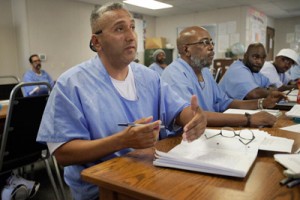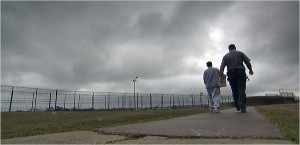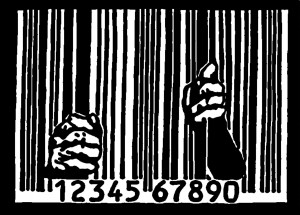I have learned a great deal when it comes to Americas education system (or lack there of) this semester. After completing my argumentative paper, there was quite a bit that a I had no idea about, and has since made me a strong advocate for the implementation of a reformed system to help our nations prisons. The image above clearly demonstrates an imbalance of Americas view on prisoners and educating them. To have any sort of incarceration on one’s record is a complete detriment to their potential employment opportunities once they are released from their stay. Not only because it requires them to check off that box on a job application, the one that says have you ever been convicted of a felony, but because while they stay in prison, most prisoners are not furthering their education while behind bars. They are essentially becoming stagnant by not betting themselves in a trade or overall education. The scales of justice are certainly unfairly tipped against them.
This is what it looks like to make the streets and neighborhoods a safer place. Not a larger presence of a police force Not a security camera on every corner, or a state prison with over-filled prison cells. It’s as simply and cost efficient as a square classroom. These gentleman (and ladies) who occupy this room are some of the luck few who reside in a state that has allowed the funds in order for them to have some form of education. The most common are the programs that allow them to complete their GED, something that most prisoners don’t even have, a traditional education that pertains to classes which would count towards an Associates Degree, and even vocational training. Any of these would leave a former inmate with better opportunities once they are inevitably released.
This gentleman has just earned his diploma while completing his prison sentence, and you can see the actual look of sheer jubilance and satisfaction in their work. Not only for the prisoner put for the instructors he’s shaking hands with. And that’s because the instructor knows the importance and the further implication of their work – that prisoner is now far less likely to become re-incarcerated. He is more likely to take what little education he has and maximize the effect of it. Be it to go out and get a job in the trade that he just finished studying, or to enroll in a local community college and complete his Associates Degree and beyond. He could even make a career out of it and contribute to society by having an honest income and pay taxes into the system. Without any of these educational programs, this gentleman would not be shaking hands with anybody. He would simply walk out of the prison system when his stay is over and be dropped off right where he left off.
And that proves to be detrimental to most inmates returning to their previous lifestyles. Lifestyles that landed them incarcerated in the first place. This inmate did not receive any education after serving his sentence. He gets to have a one-hundred yard walk to the gates, a taxi ride back to his neighborhood and not much else. This is a man who is now no more competitive in the job market than he was when he was first arrested for his crime. And now he is expected to compete against others in a job market where a Bachelors Degree gets you as far as a high school diploma did a generation ago. It is safe to say that the odds are stacked up against this man walking. In fact, it is likely that he is waking right back into his old lifestyle. The one that landed him in hot waters with the law in the first place. And to some degree, can you blame him? What does he now posses that would make him any less likely to fall back into his old ways? He knows nothing more than he did the day he was arrested, only perhaps the know-how on how to become a hardened criminal. Imagine instead if he instead knew how to weld, repair and engine, or have a high school diploma to hang on a wall. What a shame that more states don’t see that he might as well be walking on a long U-turn road which leads right back into the jail.
It’s rather sad that the nation that seemingly boasts the most nationalism and patriotism is the country with the largest prison population. It’s quite the antithesis of “land of the free.” It’s actually quite audacious to make such a claim when our prison population is larger than the population of most countries. I ponder the question “why aren’t we bettering the lives of those while they are otherwise sitting in a prison cell?” It’s a simple proposal that has been proven time and time again in other countries and even within certain states – prisoners with more education are far less likely to get caught up in the came criminal activities and overall costs the taxpayers less to do so, as opposed to keep locking up the same people for the same offenses.
It is say that politicians are the ones who promise to build a bride when there is no river. Well, in this instance there is a mighty river that needs to be crossed and there is no bridge in site. There is no real effort coming from the vast majority of our nations political leaders to implement a prison reform that favors giving those caught up in the prison industrial complex. There is no real incentive because, like most everything else, the prison system is a business. The incarcerated are not prisoners, they are customers. The higher the return rate of these customers, the higher the tax breaks, incentives and overall revenue to come through that state for improving their prison system. It’s not all that difficult to see the motives behind the actions. I certainly hope that most citizens will see what the rest of the developed world has already come to realize; that we need to aid prisoners by helping them obtain an education of sorts. And by doing so we are not only going to be a more fiscally savvy nation, but a safer one as well.





